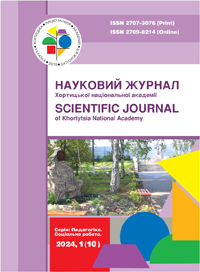УДК 376.36 ОНТОГЕНЕТИЧНІ ТА ДИЗОНТОГЕНЕТИЧНІ АСПЕКТИ ФОРМУВАННЯ ПЕРЕДКОМУНІКАТИВНИХ ТА БАЗОВИХ КОМУНІКАТИВНИХ ВМІНЬ І НАВИЧОК У ДІТЕЙ РАННЬОГО ВІКУ З УСКЛАДНЕННЯМИ РОЗВИТКУ
DOI: https://doi.org/10.51706/2707-3076-2024-10-10
Анотація
У науково-оглядовій статті на підставі результатів, отриманих авторкою у процесі теоретико-практичних досліджень проблеми формування комунікативних умінь дітей раннього віку, презентовані: (1) авторські дефініції понять «передкомунікативні вміння і навички», «базові комунікативні вміння і навички», «діти з ускладненнями розвитку» та розкрита їхня сутність; (2) проаналізований дизонтогенетичний аспект розвитку передкомунікативних та базових комунікативних вмінь і навичок; (3) проаналізовані ранні прояви патологічного розвитку передкомунікативних та базових комунікативних вмінь і навичок; (4) презентовані варіанти порушень комунікативної поведінки дітей раннього віку з ускладненнями розвитку.




 Комунальний заклад вищої освіти «Хортицька національна навчально-реабілітаційна академія» Запорізької обласної ради є закладом вищої освіти, що провадить інноваційну освітню діяльність, пов’язану з наданням вищої освіти за кількома галузями знань, проводить фундаментальні та прикладні наукові дослідження, є провідним науковим і методичним осередком, має розвинуту інфраструктуру навчальних, наукових і науково-виробничих підрозділів, сприяє поширенню наукових знань та проводить культурно-просвітницьку діяльність.
Комунальний заклад вищої освіти «Хортицька національна навчально-реабілітаційна академія» Запорізької обласної ради є закладом вищої освіти, що провадить інноваційну освітню діяльність, пов’язану з наданням вищої освіти за кількома галузями знань, проводить фундаментальні та прикладні наукові дослідження, є провідним науковим і методичним осередком, має розвинуту інфраструктуру навчальних, наукових і науково-виробничих підрозділів, сприяє поширенню наукових знань та проводить культурно-просвітницьку діяльність.